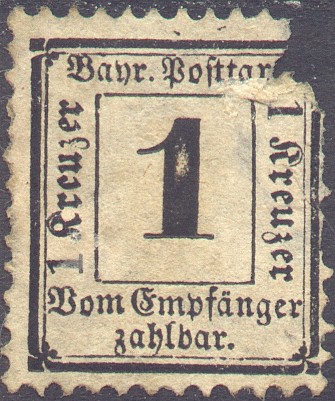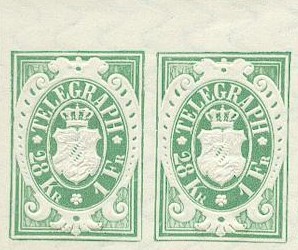

Return To Catalogue - Bavaria overview - Other German States - Germany
Note: on my website many of the
pictures can not be seen! They are of course present in the cd's;
contact me if you want to purchase them: evert@klaseboer.com.

1 k (Perforated) black 3 k (Imperforate, inscription 'Bayer') black 3 k (Perforated, inscription 'Bayr') black
The imperforated stamps should have a silk thread and a watermark. I'm not sure if the shown imperforate stamp is genuine. As with the postage stamps (see there), an 'instruction stamp' 3 k black imperforate exists without silk thread. This instruction stamp was printed on the packages with postage due stamps, so the clerks could see which stamps were inside the package.
Value of the stamps |
|||
vc = very common c = common * = not so common ** = uncommon |
*** = very uncommon R = rare RR = very rare RRR = extremely rare |
||
| Value | Unused | Used | Remarks |
| 1 k | * | RR | |
| 3 k | R | RR | Imperforate |
| 3 k | * | RR | Perforated |
The forger Fournier made forgeries of these three stamps. They are quite deceptive; sorry no images available right now. The imperforate stamp should have a silk thread, in the forgeries it is either printed or stuck on the back of the stamp. Besides the Fournier forgeries, the Serrane guide also mentions Nuremberg forgeries. I have no further information.
I think the next stamp is a forgery:
The next envelope is completely forged (envelope, stamps and cancels!) by Peter Winter. It is adressed to 'Landwirtschaftliche Verein ???? Sauschwabenheim bei Engelheim' (the text is difficult to read):

Note that this same forged envelope was also used for a Baden Stockach issue (imperforate 3 k stamp), source: 'House of Stamps 1988' catalogue.
Another example made by Peter Winter:


Probably also Winter forgeries


Some other modern forgeries. in the first 3 k stamp, the tongue
of the large '3' is too thick.
Forged cancels also exist. Example:

Postage stamps (arms issue) in grey colour and with overprint ' Vom Empfänger zahlbar' in fancy letters were issued from 1876 onwards (listed under the postage stamps for easiness by me).

(Reduced size)
1/2 s black 1 s black 7 k (25 Gr) violet 14 k blue 28 k (1 Fr) green 1 Fl 24 k orange (3 Fr) 4 Fl 40 k red 23 Fl 20 k (50 Fr) grey
I have seen reprints of these stamps. First of all, I have seen whole sheets of imperforate reprints of the 28 k value:

According to 'Die Briefmarken von Altdeutschland' by K.K. Doberer, these reprints were printed in blocks of 8 and left imperforate. Only the value 28 Kr and the value 20 pf of the next issue were reprinted. This was done in 1925 for the 'Archiv für Postgeschichte'.
Another 'Reprint' in black of the 23 Fl 20 k stamp (with embossing), made for the 46 'Bundestag' and the 93th German Philatelic day (1992) 16-18 October in Passau, said to have been made from the original stone:

(Reduced size)
The text at the btoom reads 'Abzug vom Original-Drukcstokc (Buchdruck-Prägedruck) der ersten Telegraphenmarken-Ausgabe 1870 der Kgl. Bayer. Telegraphenverwaltung'. I have seen a similar 'reprint' with the same text on top (German philatelic day Passau), but with the text at the bottom changed to: 'Faksimile-Druck der ersten Telegraphenmarken-Ausgabe 1870 der Kgl. Bayer. Telegraphenverwaltung' and with the additional text 'Faksimile' printed just below the stamp (it also has the name of the printer 'Gehringer'? printed in the left bottom part).
10 p grey 20 p violet 25 p red 40 p blue 80 p green 1 M yellow 2 M brown 4 M red 10 M silver 20 M gold
I have seen whole sheets of imperforate reprints of the 20 p value:

(Reduced size)
According to 'Die Briefmarken von Altdeutschland' by K.K. Doberer, these reprints were printed in blocks of 8 and left imperforate. Only the value 28 Kr of the previous issue and the value 20 pf of this issue were reprinted. This was done in 1925 for the 'Archiv für Postgeschichte'.